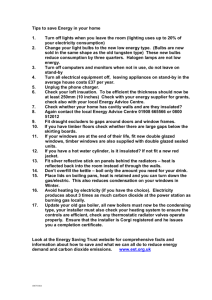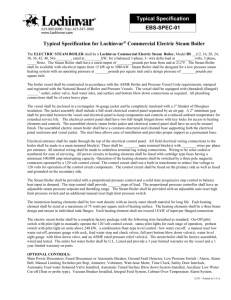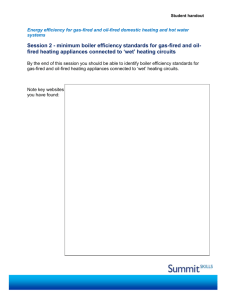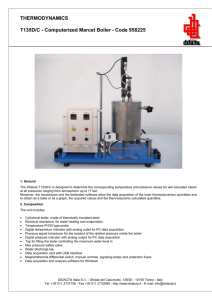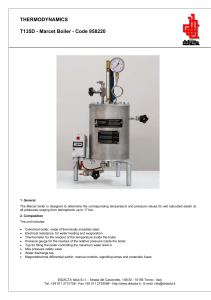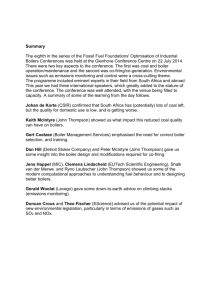GLOSSARY OF TERMS Absolute Pressure – Atmospheric Pressure
advertisement
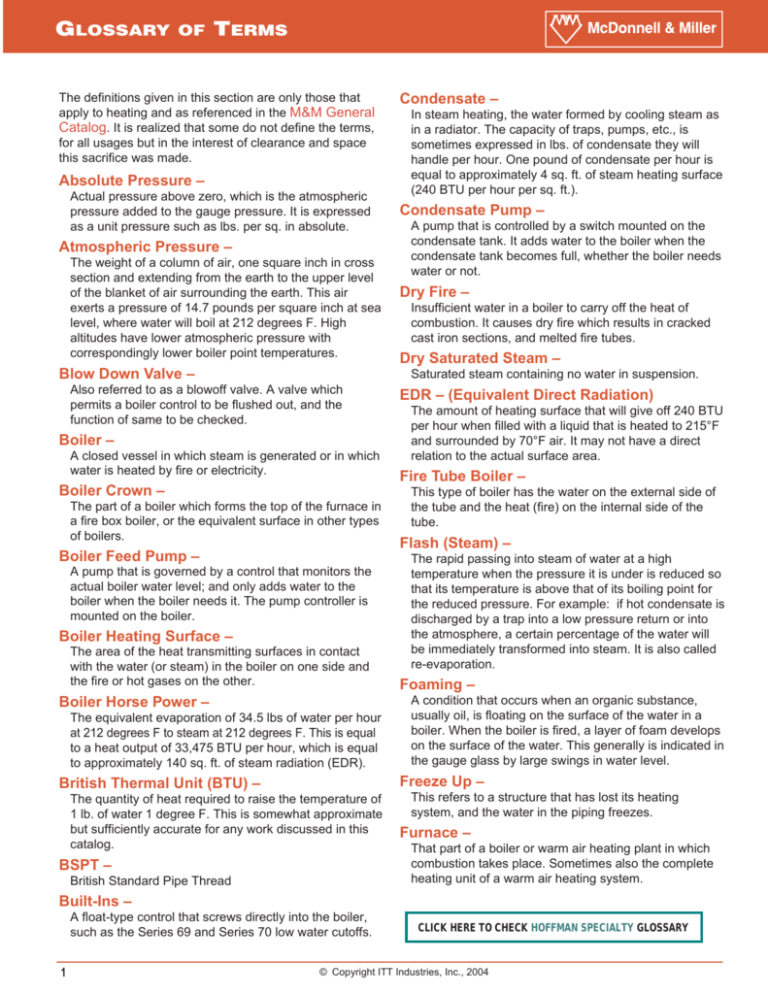
GLOSSARY OF TERMS The definitions given in this section are only those that apply to heating and as referenced in the M&M General Catalog. It is realized that some do not define the terms, for all usages but in the interest of clearance and space this sacrifice was made. Absolute Pressure – Actual pressure above zero, which is the atmospheric pressure added to the gauge pressure. It is expressed as a unit pressure such as lbs. per sq. in absolute. Atmospheric Pressure – The weight of a column of air, one square inch in cross section and extending from the earth to the upper level of the blanket of air surrounding the earth. This air exerts a pressure of 14.7 pounds per square inch at sea level, where water will boil at 212 degrees F. High altitudes have lower atmospheric pressure with correspondingly lower boiler point temperatures. Blow Down Valve – Condensate – In steam heating, the water formed by cooling steam as in a radiator. The capacity of traps, pumps, etc., is sometimes expressed in lbs. of condensate they will handle per hour. One pound of condensate per hour is equal to approximately 4 sq. ft. of steam heating surface (240 BTU per hour per sq. ft.). Condensate Pump – A pump that is controlled by a switch mounted on the condensate tank. It adds water to the boiler when the condensate tank becomes full, whether the boiler needs water or not. Dry Fire – Insufficient water in a boiler to carry off the heat of combustion. It causes dry fire which results in cracked cast iron sections, and melted fire tubes. Dry Saturated Steam – Saturated steam containing no water in suspension. Also referred to as a blowoff valve. A valve which permits a boiler control to be flushed out, and the function of same to be checked. Boiler – A closed vessel in which steam is generated or in which water is heated by fire or electricity. Boiler Crown – The part of a boiler which forms the top of the furnace in a fire box boiler, or the equivalent surface in other types of boilers. Boiler Feed Pump – A pump that is governed by a control that monitors the actual boiler water level; and only adds water to the boiler when the boiler needs it. The pump controller is mounted on the boiler. Boiler Heating Surface – The area of the heat transmitting surfaces in contact with the water (or steam) in the boiler on one side and the fire or hot gases on the other. Boiler Horse Power – The equivalent evaporation of 34.5 lbs of water per hour at 212 degrees F to steam at 212 degrees F. This is equal to a heat output of 33,475 BTU per hour, which is equal to approximately 140 sq. ft. of steam radiation (EDR). EDR – (Equivalent Direct Radiation) The amount of heating surface that will give off 240 BTU per hour when filled with a liquid that is heated to 215°F and surrounded by 70°F air. It may not have a direct relation to the actual surface area. Fire Tube Boiler – This type of boiler has the water on the external side of the tube and the heat (fire) on the internal side of the tube. Flash (Steam) – The rapid passing into steam of water at a high temperature when the pressure it is under is reduced so that its temperature is above that of its boiling point for the reduced pressure. For example: if hot condensate is discharged by a trap into a low pressure return or into the atmosphere, a certain percentage of the water will be immediately transformed into steam. It is also called re-evaporation. Foaming – A condition that occurs when an organic substance, usually oil, is floating on the surface of the water in a boiler. When the boiler is fired, a layer of foam develops on the surface of the water. This generally is indicated in the gauge glass by large swings in water level. Freeze Up – British Thermal Unit (BTU) – BSPT – Furnace – That part of a boiler or warm air heating plant in which combustion takes place. Sometimes also the complete heating unit of a warm air heating system. A float-type control that screws directly into the boiler, such as the Series 69 and Series 70 low water cutoffs. 1 CLICK HERE TO CHECK HOFFMAN SPECIALTY GLOSSARY © Copyright ITT Industries, Inc., 2004 TERMS Built-Ins – OF British Standard Pipe Thread This refers to a structure that has lost its heating system, and the water in the piping freezes. GLOSSARY The quantity of heat required to raise the temperature of 1 lb. of water 1 degree F. This is somewhat approximate but sufficiently accurate for any work discussed in this catalog. GLOSSARY OF TERMS Gauge Glass – NPT – Sometimes called water glass or sight glass. It is a device that gives a visual means of the water level in a boiler. By code, all steam boilers are required to have one. Head – Unit pressure usually expressed ft. of water or milinches of water. Overfiring – A situation where the burner does not turn off, for a number of reasons. The pressure of the system rises and the safety relief valve opens. Pilot Valve – A valve that uses a small valve to control a large valve. Heat – That form of energy into which all other forms may be changed. Heat always flows from a body of higher temperature to a body of lower temperature. See also: Latent Heat, Sensible Heat, Specific Heat, Total Heat, Heat of the Liquid. Heat of the Liquid – The heat (BTU) contained in a liquid due to its temperature. The heat of the liquid for water is zero at 32 degrees F, and increases 1 BTU: approximately for every degree rise in temperature. Heat Unit – In the foot-pound-second system, the British Thermal Unit (BTU). Heating Medium – A substance such as water, steam, or air used to convey heat from the boiler, furnace, or other source of heat to the heating units from which the heat is dissipated. Hot Water Heating System – A heating system in which water is used as the medium by which heat is carried through pipes from the boiler to the heating units. Latent Heat of Evaporation – Pressure – Force per unit area such lb. per sq. inch. Pressure Reducing Valve – A piece of equipment for changing the pressure of a gas or liquid from a higher to a lower one. Priming – When the steam leaving the boiler carries large amounts of water with it, this is called priming. Insufficient heat, water hammer, and a flooded boiler, if the system has an automatic water feeder are some of the symptoms. It is generally caused by a high water level in the boiler, and near boiler piping. Radiator – A heating unit located within the room to be heated and exposed to view. A radiator transfers heat by radiation to objects “it can see” and by conduction to the surrounding air which in turn is circulated by natural convection. Sensible Heat – Heat which only increases the temperature of objects as opposed to latent heat. Skimming – The heat (BTU of pound) necessary to change 1 pound of liquid into vapor without raising its temperature. In round numbers, this is equal to 960 BTU per pound of water. Low Pressure Steam – As defined by ASME, low pressure steam is 15 PSIG or less. Make-Up Water – Fresh water added to the system, by various means, to replace normal and abnormal water losses. Manual Reset – A control that has to have human input before the burner will come back on after a low water condition. Maximum Differential (MD) – A control with this designation has a greater spread between pump on and burner off. Minimum Safe Water Level – Also known as the minimum safe operating level. The minimum level of water in a boiler where the burner will still operate. Below this level, the burner should be off due to low water. 2 National Pipe Thread A procedure for cleaning the surface of the water in a boiler. This procedure should be done on all new boiler installations, and when there is a foaming condition. Steam – Water in the vapor phase. The vapor formed when water has been heated to its boiling point, corresponding to the pressure it is under. See also Dry Saturated Steam, Wet Saturated Steam, Super Heated Steam. Steam Heating System – A heating system in which the heating units give up their heat to the room by condensing the steam furnished to them by a boiler or other source. Steam Pop Safety Valve (Relief Valve) – A device to prevent over pressure in a boiler. It should be set for 15 psi on low pressure steam boilers. On high pressure boilers, it should be set at the maximum working pressure of the boiler, or lower if the boiler is not going to be operated at its maximum pressure. CLICK HERE TO CHECK HOFFMAN SPECIALTY GLOSSARY © Copyright ITT Industries, Inc., 2004 GLOSSARY OF TERMS Steam Trap – A device for allowing the passage of condensate and air but preventing the passage of steam. Supply Mains – The pipes through which the heating medium flows from the boiler or source of supply to the run-outs and riser leading to the heating units. Two-Pipe System (Steam or Water) – A heating system in which one pipe is used for the supply main and another for the return main. The essential feature of a two-pipe hot water system is that each heating unit receives a direct supply of the heating medium which cannot have served a preceding heating unit. Tube Bundle – A single tube (pipe) formed into a tight array so as to present a large surface area in a small space. Vacuum Heating System (Steam) – A one or two-pipe heating system equipped with the necessary accessory apparatus to permit the pressure in the system to go below atmospheric. Vapor – Any substance in the gaseous state. Vapor Heating System (Steam) – A two-pipe heating system which operates under pressure at or near atmospheric and which returns the condensation to the boiler or receiver by gravity. Vent Valve (Steam) – A device for permitting air to be forced out of a heating unit or pipe and which closes against water and steam. Vent Valve (Water) – A device permitting air to be pushed out of a pipe or heating unit but which closes against water. Water Tube Boilers – This type of boiler has the water circulated through a tube bundle with the heat applied on the external side of the tube. Wet Return (Steam) – That part of a return main of a steam heating system which is completely filled with water of condensation. CLICK HERE TO CHECK HOFFMAN SPECIALTY GLOSSARY 3 © Copyright ITT Industries, Inc., 2004
